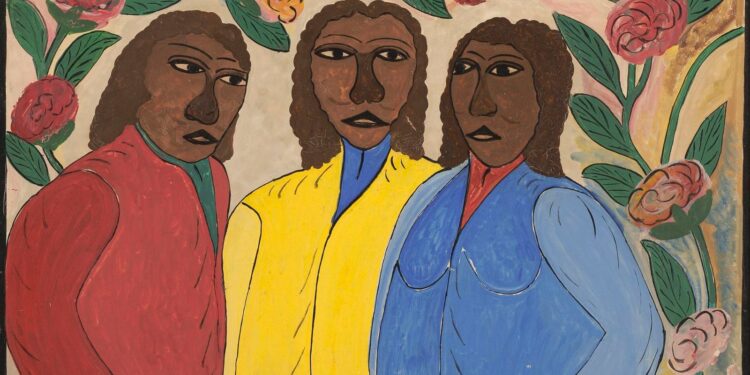Hector Hyppolite, ‘3 Marassa,’ 1947′ oil on board height: 60.96 x 60.96 cm (24 x 24 in.) National Gallery of Art, Promised Gift of Beverly and John Fox Sullivan.
Luke Christopher
America has never needed an art exhibition the way it needs тАЬSpirit & Strength: Modern Art from Haiti,тАЭ on view through March 8, 2025, at the National Gallery of Art in Washington, D.C.
Little-thought-of in America Haiti became national news this fall when presidential candidate Donald Trump and his running mate J.D. Vance spread wicked and baseless lies about Haitian immigrants in Springfield, OH. Not the typical lies told by politicians about immigrants being dangerous or taking American jobs, lies meant to cast HaitiansтАУin the country legallyтАУas sub-humans, stealing and eating peopleтАЩs pets. Outrageous even for a finely tuned right-wing lie machine that has cranked up as the November election draws closer, pivoting from Haitian immigrants barbecuing cats and dogs in middle America to conspiracies about the government controlling the weather and making hurricanes stronger.
Republican Party slander about Haitian immigrants in Springfield led directly to bomb threats and the closure of schools and government buildings.
The National GalleryтАЩs exhibition was announced almost a year ago in conjunction with a major gift Haitian art. ItтАЩs connection to the news cycle is purely coincidental. And fortunate. Here is where art, and art museums, can demonstrate their greatest powers. Art museums doubling as the nationтАЩs best history museums. Art as lie-debunker. Art as an empathy machine. Art as travel guide. Art as de-otherer.
How many Americans realize that Haiti became the worldтАЩs first free Black republic in 1804? That Haitians pulled off the worldтАЩs largest and most successful slave revolt against French colonizers to achieve their freedom? That Haiti was the first nation to outlaw slavery?
тАЬThe enormous contribution to human rights, to the concept of human rights in the modern world,тАЭ Brooklyn College City University of New York Haitian Studies Institute Director Marie Lily Cerat told Forbes.com when asked what she wished more Americans understood about Haiti. тАЬHaiti represents the only place in the world where a (successful) slave revolt occurred and you had former slaves creating this space where the idea of liberty, equality, and brotherhood was really illustrated.тАЭ
How many Americans know that slaveholding U.S. president Thomas Jefferson refused to recognize HaitiтАЩs nationhood, fearing what ideas it may give the enslaved among his country.
тАЬHaiti challenged the idea of keeping Africans enslaved for the United States and elsewhere, but (enslavers) knew what was happening, and not just the founding fathers of this nation, but around Europe,тАЭ Cerat explained. тАЬPeople knew that the idea of slavery was a false narrative to exploit people who were less equipped with weapons of war to create wealth. They knew that Black people were not inferior.тАЭ
Jefferson and the Americans had words and ideals promoting equality, liberty, the pursuit of happiness. Words and ideals they didnтАЩt have the conviction to put into action.
тАЬHaitians believe in those ideals of every person is created equal and that was manifested by the slave revolt and the establishment of this nation at the dawn of the 19th century,тАЭ Cerat said. тАЬIt really gave birth to the idea of what we know as human rights, modern day human rights.тАЭ
Haitians even fought for American independence on the battlefield during the Revolutionary War, most prominently at 1779тАЩs Battle of Savannah? How many Americans know that?
Still, the United States didnтАЩt recognize Haiti as a nation until 1862, during the Civil War, when American leadership was looking for any support in discrediting slavery.
Problems And Causes
PORT-AU-PRINCE, HAITI – FEBRUARY 22: Gang Leader Jimmy ‘Barbecue’ Cherizier with G-9 federation gang members in the Delmas 3 area on February 22, 2024 in Port-au-Prince, Haiti. There has a been fresh wave of violence in Port-au-Prince where, according to UN estimates, gangs control 80% of the city. (Photo by Giles Clarke/Getty Images)
Getty Images
What most Americans do know about HaitiтАУor at least have heard aboutтАУare the nationтАЩs innumerable crises. Rampant gang violence of a severity scarcely imaginable. Political chaos. Hunger. A collapsed economy.
All true.
With an asterisk.
тАЬ(Haitians) owe some responsibility for where we are, but we didn’t get there alone,тАЭ Cerat, who was born and raised in Haiti and immigrated to Brooklyn in 1981, said. тАЬThe West, including the United StatesтАж forever, the United States says, тАШHaiti is our friend.тАЩ With friends like this, we don’t need enemies.тАЭ
How many Americans realize their nation violently occupied Haiti from 1915 to 1934, openly controlling its military and finances, and government from behind the scenes? America and Western nations meddling in Haitian affairs is a tradition dating back to that countryтАЩs founding.
Shortly after winning its independence from France, HaitiтАЩs former colonial occupier threatened to invade the nation unless it paid steep reparations to the former slaveholders there, making them economically whole. ThatтАЩs right. Free Haitians were forced to pay billions of dollars in todayтАЩs money to their former enslavers as reparations at the point of a gun. Those reparations crippled the nationтАЩs formation.
тАЬHistorians recognize that the West has conspired to make it seem like Haiti canтАЩt rule themselves, because how do we let this Black republic rise right here,тАЭ Cerat said.
The meddling continued, nearly unabated, to present day.
тАЬWhen the Haitians finally, finally ousted Duvalier in тАЩ86тАУthe father and son dictatorship that was supported by the United States for fear of Haiti becoming like Cuba, for fear of communism, they supported the Duvalier regime (which) had a terrible, terrible human rights record, but (the U.S.) supported them for 30 yearsтАУwhen the Haitians finally elected Jean-Bertrand Aristide in 1990-1991, the U.S., Canada, France, they masterminded the coup dтАЩ├йtat that would oust Aristide,тАЭ Cerat explained.
The story would repeat itself in 2004.
Haiti used to be able to produce enough rice to feed its citizens. Then the United States began dumping Arkansas grown rice there, devastating HaitiтАЩs rice growers. The Arkansas grown president responsible for that catastrophe, Bill Clinton, has subsequently said, тАЬI have to live every day with the consequences of the lost capacity to produce a rice crop in Haiti to feed those people, because of what I did.”
And on, and on, and on.
Exacerbating HaitiтАЩs troubles, an extraordinary sequence of devastating natural disasters over the past 15 yearsтАУearthquakes, hurricanes, floodsтАУincluding a 2010 earthquake that killed an estimated 220,000 people and left 1.5 million homeless.
Spirit And Strength
Andre Pierre, ‘Mambo,’ early 1960s’ oil on fiberboard unframed: 25.4 x 20.32 cm (10 x 8 in.) National Gallery of Art, Gift of Kay and Roderick Heller.
National Gallery of Art, Washington, Collection of Mr. and Mrs. Paul Mellon, 1983.1.18
The art exhibition doesnтАЩt take politics as its focus. The National GalleryтАЩs intent is highlighting the development of Modern art in Haiti. Included are some of the most prominent artists to have lived or worked there over the past century, and the first chance to see 21 works by modern and contemporary Haitian artists from the historic 2023 gift.
тАЬThe Gallery is interested in expanding the stories we tell about the history of art and demonstrating the transcultural nature of modernism in the East Building,тАЭ exhibition curator and associate curator of African American and Afro-Diasporic art at the National Gallery Kanitra Fletcher told Forbes.com. тАЬThe great influence of Haiti and Haitian art in art history is underknown, especially in the U.S., and we were given a wonderful opportunity to acquire several examples by the most renowned Haitian artists to be able to tell that history.тАЭ
Works from Haitian artists are joined in the presentation by those from African American artists like Lois Mailou Jones, Jacob Lawrence, and William Edouard Scott, who visited Haiti between the 1930s and 70s, looking to the nation as a source of inspiration, demonstrating the remarkable reach of Haitian artistic production.
тАЬTheir visits were transformative, and in some cases, prolific. William E. Scott created over 100 works during a 13-month stay in Haiti,тАЭ Fletcher explained. тАЬHaitian art became internationally popular and widely influential from the 1940s to 1970s. Many of the artists (in тАШSpirit & StrengthтАЩ) were shown in exhibitions and entered major private and public collections in the U.S. at that time. Haitian artwork also was being shown outside of the country when American and European modern artists began to draw inspiration from the artistic traditions of cultures in the Caribbean, Latin America, Africa, and Native American communities to develop Modern art as we know it.тАЭ
Most of the featured Haitian artists were associated with the Centre dтАЩArt, an important school, gallery, and cultural institution founded in 1944 in Port-au-Prince by the American artist DeWitt Peters. In an effort to expand the existing scholarship, the exhibition will also present artwork related to the Haitian Indigenist Movement, which preceded the establishment of the Centre dтАЩArt.
тАЬItтАЩs not a single picture (of Haiti that emerges through the artwork), but rather several, of daily life, historical events, and spiritual traditions demonstrating the complexity of Haiti and the artistic styles that have come out of the country,тАЭ Fletcher said.
Haitians and America
Wilson Bigaud, ‘Adam and Eve,’ 1953; oil on board height: 63.5 x 77.47 cm (25 x 30 1/2 in.) National Gallery of Art, Promised Gift of Beverly and John Fox Sullivan.
Copyright 2023 Luke Christopher All Rights Reserved
Donald Trump is holding fiercely to his anti-Haitian, anti-immigrant bigotry.
тАЬI saw a headline where Trump, again, doubling down and tripling down on the idea that Haitians are undesirable, (that) Haitians should not be here, said those people are bringing bad genes. ThatтАЩs eugenics. ThatтАЩs a white supremacist idea. ThatтАЩs a fascist idea,тАЭ Cerat said.
On October 7, 2024, Trump appeared on a right-wing radio show, again espousing his belief that genetic predisposition based on race determines a personтАЩs capacity of intellect, tendency toward violence, and likelihood of success. He claimed immigrants have тАЬbad genes.тАЭ That racist ideology is known as eugenics.
Eugenics was a pseudoscience popular in America during the early decades of the 20th-century, a belief that perfect humansтАУand a perfect societyтАУcould be created through controlled human breeding for a supposed ideal genetic makeup. The notion served as backbone for Adolph HitlerтАЩs desired Aryan race.
EugenicsтАЩ connection to Hitler caused it to fall out of fashion in America, until its rebirth, thanks to Trump.
America has never needed an art exhibition the way it needs тАЬSpirit & Strength: Modern Art from Haiti.тАЭ Admission is free.
Source link : http://www.bing.com/news/apiclick.aspx?ref=FexRss&aid=&tid=6707fad5391e4d27b42c81441301168d&url=https%3A%2F%2Fwww.forbes.com%2Fsites%2Fchaddscott%2F2024%2F10%2F10%2Fhaitian-modern-art-at-the-national-gallery-in-washington-dc%2F&c=12119315740567631976&mkt=en-us
Author :
Publish date : 2024-10-10 04:58:00
Copyright for syndicated content belongs to the linked Source.












